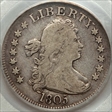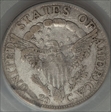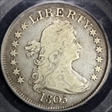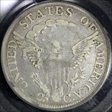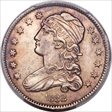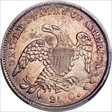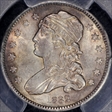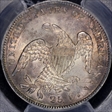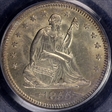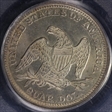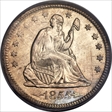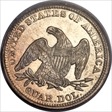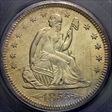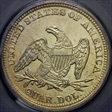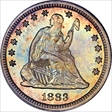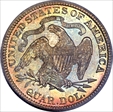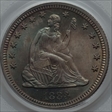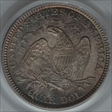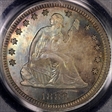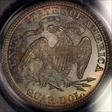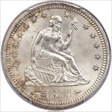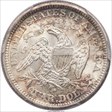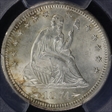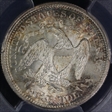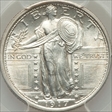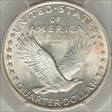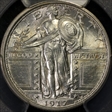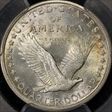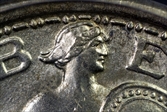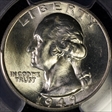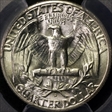The Kankakee Collection 的钱币相册
B-2 (Browning). This lovely Select Mint State example is tied for the eighth finest according to the Rea-Koenings-Haroutunian Condition Census that is presented in Early Quarter Dollars of the US Mint (2010). The obverse is cracked from the hair curl to the three lowest stars on the right, apparently as always. This variety was produced before 1832 B-1. Both sides exhibit frosty mint luster with delicate gold, champagne, and steel toning on the ivory surfaces. Population: 13 in 63, 16 finer
B-2 (Browning). This lovely Select Mint State example is tied for the eighth finest according to the Rea-Koenings-Haroutunian Condition Census that is presented in Early Quarter Dollars of the US Mint (2010). The obverse is cracked from the hair curl to the three lowest stars on the right, apparently as always. This variety was produced before 1832 B-1. Both sides exhibit frosty mint luster with delicate gold, champagne, and steel toning on the ivory surfaces. Population: 13 in 63, 16 finer
B-2 (Browning). This lovely Select Mint State example is tied for the eighth finest according to the Rea-Koenings-Haroutunian Condition Census that is presented in Early Quarter Dollars of the US Mint (2010). The obverse is cracked from the hair curl to the three lowest stars on the right, apparently as always. This variety was produced before 1832 B-1. Both sides exhibit frosty mint luster with delicate gold, champagne, and steel toning on the ivory surfaces. Population: 13 in 63, 16 finer
B-2 (Browning). This lovely Select Mint State example is tied for the eighth finest according to the Rea-Koenings-Haroutunian Condition Census that is presented in Early Quarter Dollars of the US Mint (2010). The obverse is cracked from the hair curl to the three lowest stars on the right, apparently as always. This variety was produced before 1832 B-1. Both sides exhibit frosty mint luster with delicate gold, champagne, and steel toning on the ivory surfaces. Population: 13 in 63, 16 finer
Briggs 1-A, showing a die break from the lower left rear of the arrow to the 1 in the date, and die scratches on the reverse above TAT and ME. A curious and interesting example of this type issue, struck from dies that appear to have been axially misaligned, creating a sharp strike at areas near the rims on each side and notable weakness in other peripheral areas. The weakest area of strike on the obverse is 9 to 12 o'clock, and on the reverse 6 to 9. Attractive sandy-gold luster with deeper rose color and a patch of pale blue complement the overall good eye appeal and decent preservation. Population: 18 in 64, 11 finer
Briggs 1-A, showing a die break from the lower left rear of the arrow to the 1 in the date, and die scratches on the reverse above TAT and ME. A curious and interesting example of this type issue, struck from dies that appear to have been axially misaligned, creating a sharp strike at areas near the rims on each side and notable weakness in other peripheral areas. The weakest area of strike on the obverse is 9 to 12 o'clock, and on the reverse 6 to 9. Attractive sandy-gold luster with deeper rose color and a patch of pale blue complement the overall good eye appeal and decent preservation. Population: 18 in 64, 11 finer
Briggs 1-A, showing a die break from the lower left rear of the arrow to the 1 in the date, and die scratches on the reverse above TAT and ME. A curious and interesting example of this type issue, struck from dies that appear to have been axially misaligned, creating a sharp strike at areas near the rims on each side and notable weakness in other peripheral areas. The weakest area of strike on the obverse is 9 to 12 o'clock, and on the reverse 6 to 9. Attractive sandy-gold luster with deeper rose color and a patch of pale blue complement the overall good eye appeal and decent preservation. Population: 18 in 64, 11 finer
Briggs 1-A, showing a die break from the lower left rear of the arrow to the 1 in the date, and die scratches on the reverse above TAT and ME. A curious and interesting example of this type issue, struck from dies that appear to have been axially misaligned, creating a sharp strike at areas near the rims on each side and notable weakness in other peripheral areas. The weakest area of strike on the obverse is 9 to 12 o'clock, and on the reverse 6 to 9. Attractive sandy-gold luster with deeper rose color and a patch of pale blue complement the overall good eye appeal and decent preservation. Population: 18 in 64, 11 finer
Briggs 1-A, showing a die break from the lower left rear of the arrow to the 1 in the date, and die scratches on the reverse above TAT and ME. A curious and interesting example of this type issue, struck from dies that appear to have been axially misaligned, creating a sharp strike at areas near the rims on each side and notable weakness in other peripheral areas. The weakest area of strike on the obverse is 9 to 12 o'clock, and on the reverse 6 to 9. Attractive sandy-gold luster with deeper rose color and a patch of pale blue complement the overall good eye appeal and decent preservation. Population: 18 in 64, 11 finer
Briggs 1-A, showing a die break from the lower left rear of the arrow to the 1 in the date, and die scratches on the reverse above TAT and ME. A curious and interesting example of this type issue, struck from dies that appear to have been axially misaligned, creating a sharp strike at areas near the rims on each side and notable weakness in other peripheral areas. The weakest area of strike on the obverse is 9 to 12 o'clock, and on the reverse 6 to 9. Attractive sandy-gold luster with deeper rose color and a patch of pale blue complement the overall good eye appeal and decent preservation. Population: 18 in 64, 11 finer
CAC. PCGS has seen 19 submissions in MS66 (one in MS66+) and three finer. This is among six in this grade with the CAC green bean.The stars on this lavishly patinated Premium Gem show full centers and radial lines. Definition is equally bold on Liberty's head, the eagle's wing feathers, claws, and arrow fletchings. Briggs 2a. Perhaps 800 total survive.
CAC. PCGS has seen 19 submissions in MS66 (one in MS66+) and three finer. This is among six in this grade with the CAC green bean.The stars on this lavishly patinated Premium Gem show full centers and radial lines. Definition is equally bold on Liberty's head, the eagle's wing feathers, claws, and arrow fletchings. Briggs 2a. Perhaps 800 total survive.
CAC. PCGS has seen 19 submissions in MS66 (one in MS66+) and three finer. This is among six in this grade with the CAC green bean.The stars on this lavishly patinated Premium Gem show full centers and radial lines. Definition is equally bold on Liberty's head, the eagle's wing feathers, claws, and arrow fletchings. Briggs 2a. Perhaps 800 total survive.
CAC. PCGS has seen 19 submissions in MS66 (one in MS66+) and three finer. This is among six in this grade with the CAC green bean.The stars on this lavishly patinated Premium Gem show full centers and radial lines. Definition is equally bold on Liberty's head, the eagle's wing feathers, claws, and arrow fletchings. Briggs 2a. Perhaps 800 total survive.
CAC. PCGS has seen 19 submissions in MS66 (one in MS66+) and three finer. This is among six in this grade with the CAC green bean.The stars on this lavishly patinated Premium Gem show full centers and radial lines. Definition is equally bold on Liberty's head, the eagle's wing feathers, claws, and arrow fletchings. Briggs 2a. Perhaps 800 total survive.
CAC. PCGS has seen 19 submissions in MS66 (one in MS66+) and three finer. This is among six in this grade with the CAC green bean.The stars on this lavishly patinated Premium Gem show full centers and radial lines. Definition is equally bold on Liberty's head, the eagle's wing feathers, claws, and arrow fletchings. Briggs 2a. Perhaps 800 total survive.
Briggs 1-A. Forest-green and tobacco-brown toning accompanies the borders, while the fields and motifs are principally brilliant. A crisply struck, frosty, and thoroughly lustrous Premium Gem that boasts superior eye appeal. PCGS reports just five numerically finer examples. Population: 36 in 66 (2 in 66+), 5 finer
Briggs 1-A. Forest-green and tobacco-brown toning accompanies the borders, while the fields and motifs are principally brilliant. A crisply struck, frosty, and thoroughly lustrous Premium Gem that boasts superior eye appeal. PCGS reports just five numerically finer examples. Population: 36 in 66 (2 in 66+), 5 finer
Briggs 1-A. Forest-green and tobacco-brown toning accompanies the borders, while the fields and motifs are principally brilliant. A crisply struck, frosty, and thoroughly lustrous Premium Gem that boasts superior eye appeal. PCGS reports just five numerically finer examples. Population: 36 in 66 (2 in 66+), 5 finer
Briggs 1-A. Forest-green and tobacco-brown toning accompanies the borders, while the fields and motifs are principally brilliant. A crisply struck, frosty, and thoroughly lustrous Premium Gem that boasts superior eye appeal. PCGS reports just five numerically finer examples. Population: 36 in 66 (2 in 66+), 5 finer




















